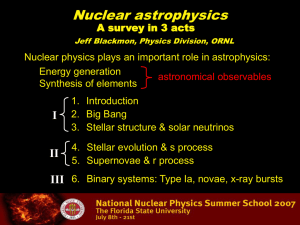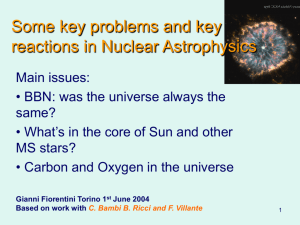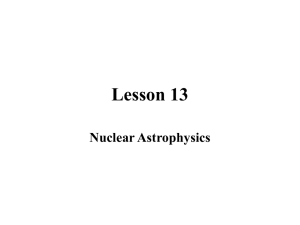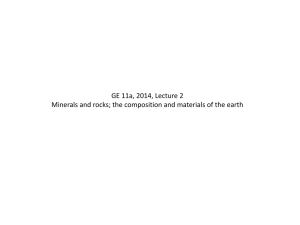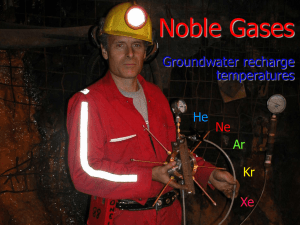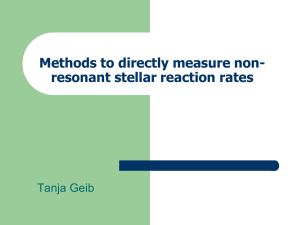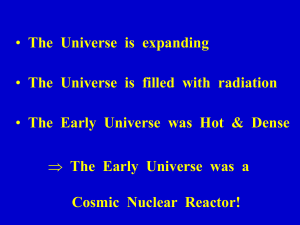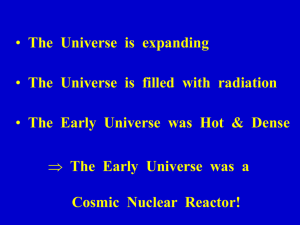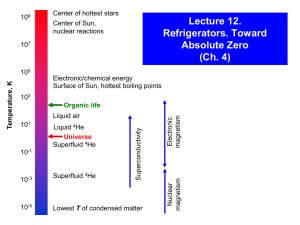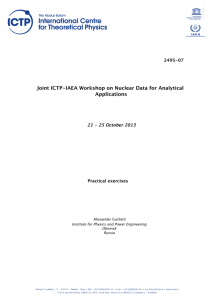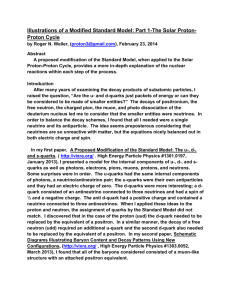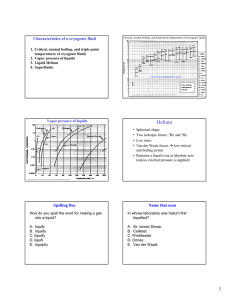Big Bang Nucleosynthesis
advertisement
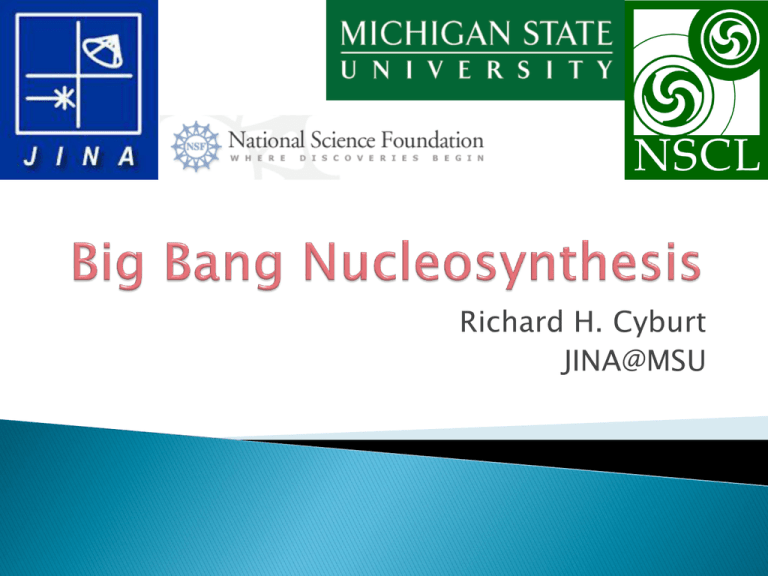
Richard H. Cyburt JINA@MSU Hydro NSE Static Iron Nucl. Group Heavy Element Nucleosynthesis s-process r-process p-process If universe ~14 Gyr old ◦ Where’d we get so much H & He??? pp-chain is too slow massive stars burn beyond He ◦ Stars must have been born with that H & He Big bang nucleosynthesis What building blocks are available? ◦ n, p, nuclides, e, g, n, etc… What are the reaction time scales? ◦ Related to rxn rates: t = 1/G What are the dynamical time scales? ◦ Hydro-static EQ; no time scale ◦ Free-fall time t = finite First published in Weltall and Menschheit (1907) edited by Hans Kraemer Cosmological Principle ◦ Universe is homogeneous looks the same anywhere we go ◦ Universe is isotropic looks the same any direction we look ◦ Laws of physics are the same everywhere(when) General Relativity ◦ theory of gravity Standard Model of Particle Physics ◦ Constituents of normal matter ◦ Interactions between them Dark Side of Cosmology ◦ Dark Matter ◦ Dark Energy Courtesy of George Lucas GR predicts universe is expanding ◦ Einstein tried to fix this with L ◦ Claims its his biggest mistake Hubble obs. recession of galaxies (1929) ◦ First evidence for universal expansion ◦ Subsequent obs. confirm this If the universe is expanding…. ◦ What was it like in the past? •Smaller •Hotter •Denser ◦ What happens to its constituents? Baryons- n, p, nuclides At kT>1 MeV ◦ Thermal equilibrium ◦ Chemical equilibrium ◦ Main constitients } NSE Photons Neutrinos Electrons/positrons Small number of baryons (n & p) n/p = exp(-Dm/T) Dynamical timescale ◦ Hubble expansion rate H ~ T2/MP Reaction timescales ◦ Weak interaction GW ~ T5/MW4 ◦ Rxn rates Grxn ~ rBlrxn When T~1 MeV ◦ GW~H weak rates become slow n’s stop interacting ◦ Electrons/positrons become NR e+ + e2g energy goes into all but n’s Tg > Tn n,p would like to fuse into d But Ng(E>Bd) >> NB ◦ So as soon as d is made, it is destroyed ◦ So we must wait….. Called the D bottleneck while we wait, n’s decay T~70 keV, d not efficiently destroyed So……. p(n,g)d(p,g)3He(d,p)4He We convert H into 4He (all n’s go into 4He) Sometimes we even 3He(a,g)7Be T~40 keV, Coulomb barrier halts nucl. Light Element Abundances Agreemen t He: known syst. 4 Olive & Skillman 2004 D: few obs. systems Burles, Kirkman, O’Meara He: extrap. error 3 Disagreemen t Bania et al, Vangioni-Flam et al 7Li: add. syst.? Spite & Spite, Ryan et al, Bonifacio et al WMAP CMB WBh2 Bennet et al, Spergel et al Obs./Exp./Thry. Systematics (Cyburt 2004; Descouvemont et al. 2004; Serpico et al. 2004) Nuclear Astrophys./Chemical Evolution (Vangioni-Flam et al. 2002; Bono et al.2002; Cassisi, Salaris & Irwin 2003) Physics beyond Standard Model (Malaney & Mathews 1993; Sarkar 1996; Cyburt, Fields & Olive 2004) Nuke fixes: Missing Reactions? Doesn’t significantly alter the final abundance predictions!!!! Coc et al. ApJ 744 (2012) 158 Boyd et al PRD 82 (2010) 105005 7Be(d,pa)4He 3He(a,g)7Be 7Li S34 Can fix 7Li, but… lose Solar n flux SNO+S17+SSM=S34 (Ahmed et al, Cyburt et al, Bahcall) S27 100 old value Coc et al (2004) New expt performed Angulo et al (2005) No impact on BBN What about a missing resonance? Rule out renorm >99% (Cyburt & Pospelov arXiv: 0906.4373) Not strong enough!!! Kirseborn & Davids PRC 84 (2011) 058801 O’Malley et al PRC 84 (2011) 042801 Non-thermal processes (Voronchev, Nakao, Tsukida, & Nakamura PRD 85 (2012) 067301) d(d,n)3He, d(d,p)t, 3He(d,p)4He, t(d,n)4He n,p from rxns are highly non-thermal Slowed in plasma, but still partially non-thermal Can enhance some reactions However, thermalization is too strong at BBN T’s Changes in abundances <1% See also non-Maxwellian distributions (Bertulani et al arXiv:1205.4000) and electron screening affects on BBN (PRC83 (2011) 018801 Obs syst errors larger or depletion? Some evidence of Li depletion ◦ 6,7Li(p,a) (Masseron et al arXiv: 1203.3295) (Lind et al. arXiv: 1001.5153) rxns deplete Li Pre-MS stars (Molaro et al. arXiv: 1206.1298, Yee and Jensen ApJ 711 (2010 303 & Bildsten et al ApJ 482 (1997) 442) MS stars (Korn et al. Nature 442 (2006) 657) Can we deplete uniformly without increasing the observed dispersion? Better astro models needed! Variation of fundamental constants? Dark radiation or neutrino degeneracy? Beyond the SM….. SUSY? (Cyburt, Ellis, Fields, Luo, Olive & Spanos; Kawasaki, Kohri & Moroi; Mathews, Kajino; Jedamzik) BBN is the first epoch of nucleosynthesis Involves all 4 fundamental forces of nature Standard BBN w/ CMB is parameter free Accurately predict light element abundances Concordance w/ 4He, 3He and D obs. 7Li remains a problem!! 6Li is not a problem!! Steffen et al. arXiv: 1206.2239
